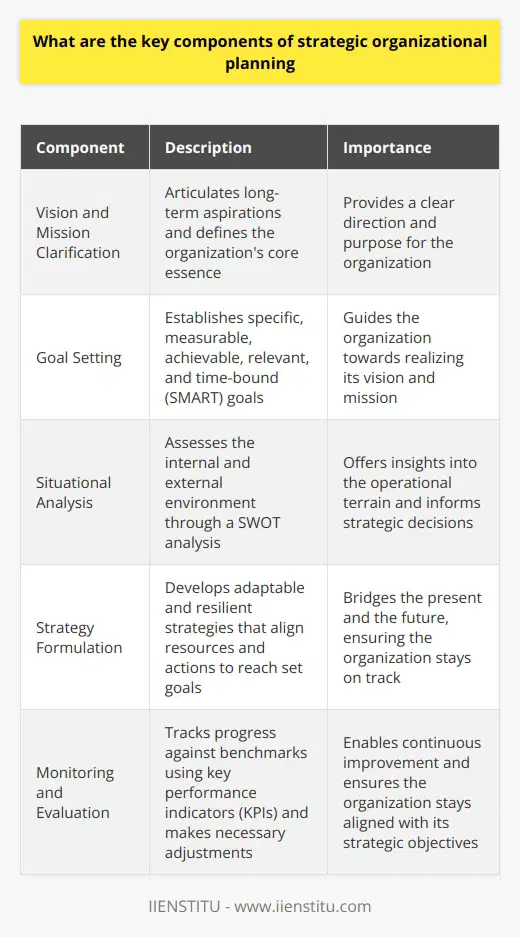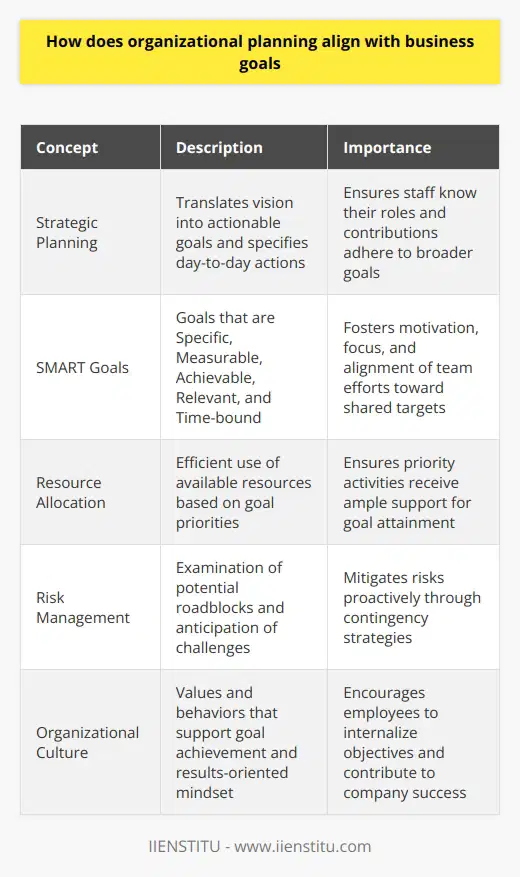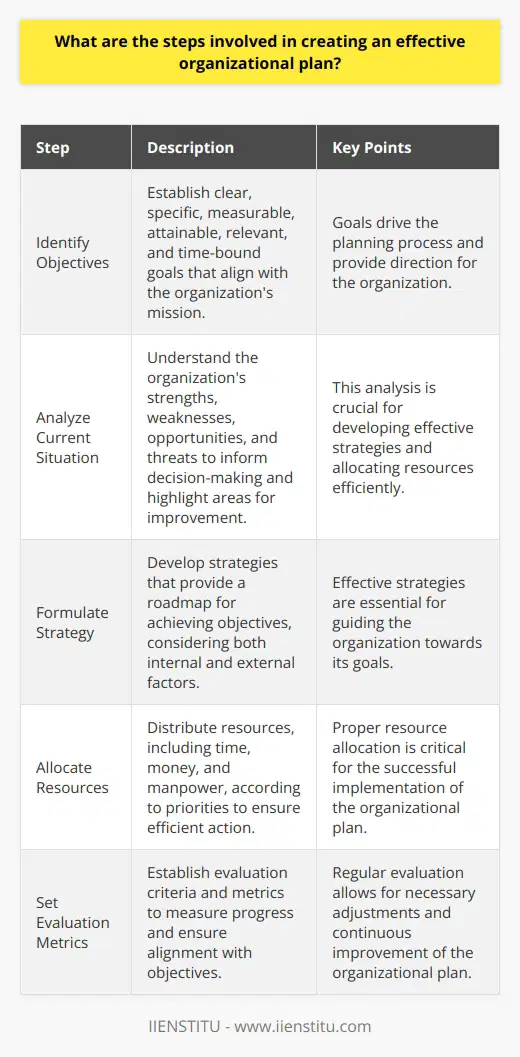
Introduction to Organization Planning
Definition and Importance
Organization planning is an essential management activity that involves the creation and maintenance of a plan to help guide an organization toward its future goals and objectives.
At its core, it is about aligning the company's mission, vision, and tactics with operational activities, ensuring that all components of the organization work synergistically toward common objectives. This form of planning becomes the crucible within which organizational decisions are tested and strategic directions are chosen.
The objective of this blog is to provide a comprehensive view on organization planning. We aim to delve into the structured approach of strategic guides for organization planning, parse through the understanding and benefits of this activity, identify key elements that are critical for success, and share effective organization planning tactics that can be implemented.
For those involved in MBA courses or pursuing certificate courses online in related fields, this blog will serve as an essential resource that bridges theory with real-world application.
Strategic Guide for Organization Planning
Overview of Strategic Planning in Organizations
Strategic planning bridges the gap between where an organization is and where it aspires to be. It is about defining a direction and allocating resources to activities that endeavor impactful progress. A robust strategic plan can offer a sense of direction and outline measurable goals that organizations can follow in a structured manner.
The Process of Developing a Strategic Plan
Vision and Mission Definition
The starting point for any strategic plan involves clarifying the organization's vision and mission. These statements articulate the purpose of the company and its aspirations, creating a guidepost for all subsequent planning activities.
Analysis of the Organization’s Current State
Once the mission and vision are articulated, organizations must critically assess their current status. This means identifying strengths, weaknesses, opportunities, and potential threats through a detailed environmental scan.
Setting Strategic Goals and Objectives
Next, strategic goals and objectives are established. These should be specific, measurable, achievable, relevant, and time-bound (SMART), and they should support the overarching vision and mission of the organization.
Crafting a Roadmap for Achievement
After setting goals, the process moves onto crafting a strategic roadmap. This involves breaking down the overall strategy into actionable steps and identifying required resources and potential obstacles.
Implementation Strategies
Lastly, implementation strategies are developed to actualize the plan. This will demand efficient coordination, management of resources, and progressive monitoring of execution against established benchmarks.
Understanding Organization Planning
Theoretical Foundations of Organization Planning
Organization planning is built upon the foundation of theories ranging from classical management to modern strategic management practices. Its academic basis comprises of planning principles that have been evolved over centuries of organizational development and leadership thought.
Differentiating between Strategic, Tactical, and Operational Planning
It is crucial to differentiate between strategic, tactical, and operational planning. Strategic planning is the high-level view focusing on long-term goals and direction-setting, while tactical planning is the bridge that translates strategic objectives into specific actions. Operational planning is the final execution phase where strategies are turned into day-to-day tasks.
Benefits of Organization Planning
Enhanced Decision-Making Abilities
Organization planning enhances decision-making by providing a framework based on which decisions can be made. It ensures that all decisions align with the broader strategic objectives of the company.
Improved Resource Allocation
Effective planning allows for better resource allocation by identifying priority areas that require investment and ensuring that resources are directed toward high-impact activities.
Proactivity and Future Preparedness
By anticipating future trends and challenges, organization planning fosters a proactive culture rather than a reactive one, allowing the organization to seize opportunities and mitigate risks ahead of time.
Boosting Organizational Alignment and Performance
Strategic organization planning ensures that every department and employee is aligned with the organization's objectives, thus improving overall performance and cohesiveness.
Case Studies Illustrating the Benefits
Numerous case studies have shown how organization planning can turn around businesses and foster growth. These real-world examples act as testimonials to the power of strategic planning.
Key Elements of Organizational Planning
Mission, Vision, and Values
The mission, vision, and values form the bedrock of organization planning. They offer clarity and direction and serve as the north star for all organizational endeavors.
Environmental Scanning: Internal and External
Conducting environmental scans—both internal and external—helps an organization understand its position in the market and within its own walls.
SWOT Analysis: Strengths, Weaknesses, Opportunities, and Threats
SWOT analysis is a critical tool used during the planning process that aids in identifying opportunities for growth and areas that need improvement.
Strategy Formulation and Selection
Strategy formulation involves choosing the appropriate strategies that will help the organization achieve its identified objectives effectively.
Implementation Considerations
Considerations of implementation include establishing timelines, defining responsibilities, and determining the resources needed to carry out the plan.
Monitoring and Feedback Mechanisms
Lastly, a sound organizational plan requires monitoring and feedback mechanisms to assess progress and make necessary adjustments. This cycle of review and revision is vital for the dynamic nature of strategic pursuits.
Effective Organization Planning Tactics
Involving Stakeholders in the Planning Process
Involvement of stakeholders in the planning process ensures buy-in and allows for a diverse range of perspectives to inform the strategy. This inclusive approach often leads to more resilient and well-rounded plans.
Use of Technological Tools for Efficient Planning
The utilization of technological tools can streamline the planning process, making it more efficient and accurate. From project management software to data analytics, technology plays a crucial role in contemporary strategic planning.
Continuous Learning and Adaptation
In a world that is continuously changing, organization planning must involve continuous learning and adaptation. Staying agile allows an organization to pivot quickly in response to new information or changes in the business environment.
Success Measurement and Adjustment Strategies
Setting benchmarks for success and having clear adjustment strategies is vital for gauging progress and ensuring the strategic plan remains on track.
Real-world Examples of Effective Tactics
Real-world examples serve as valuable learning tools and inspiration, showcasing the effective application of organization planning tactics and reinforcing the relevant strategies discussed.
Recap of The Essentials of Organization Planning
Organization planning is a central function of management that ensures an organization's survival and success in a complex, ever-changing environment. It requires a clear understanding of strategic, tactical, and operational planning components and a commitment to transparency, involving stakeholders, and willingness to adapt.
Encouragement for Strategic Approach Adoption
Ultimately, this strategic guide encourages organizations to adopt a strategic approach to their planning efforts. Those who master the art and science of organization planning will navigate the uncertain terrain of modern business with confidence and expertise.
Frequently Asked Questions
What are the key components of strategic organizational planning
Strategic Organizational Planning: A Closer Look
Strategic organizational planning stands as a cornerstone for successful enterprises. It encompasses various elements, each essential in its right, striving towards a cohesive set of objectives. Understanding these components enriches our grasp of the complex tapestry of organizational strategy.
Vision and Mission Clarification
Every organization rests on a foundation of purpose. The vision articulates long-term aspirations. It captures the ultimate endgame. Conversely, the mission delineates the present-day activities. It defines the organization's core essence.
Goal Setting
Effective planning roots in clear goals. These are the directional beacons for any organization. They must be Specific, Measurable, Achievable, Relevant, and Time-bound (SMART). Achievement of these goals pushes the organization closer to its vision.
Situational Analysis
No plan shapes up in a vacuum. Understanding the internal and external environment is crucial. It includes a SWOT analysis — Strengths, Weaknesses, Opportunities, and Threats. It offers insights into the operational terrain.
Strategy Formulation
Here lies the heart of planning. Leaders formulate strategies that align resources and actions. They map out ways to reach the set goals. Strategies bridge the present and the future. They must be adaptable and resilient.
Resource Allocation
Resources are finite. Strategic planning entails their judicious distribution. Human, financial, and material resources require optimization. Every goal gets the necessary inputs. Wastage minimizes. Efficiency maximizes.
Implementation
Plans mean little without action. Implementation constitutes the actual execution of strategies. It demands coordination and communication. Here, leaders mobilize teams to turn plans into reality. Progress propels forward.
Monitoring and Evaluation
Feedback loops are vital. They measure progress against benchmarks. This phase involves tracking key performance indicators (KPIs). Adjustments ensue when necessary. Continuous improvement is the aim.
Stakeholder Engagement
No organization exists in isolation. Stakeholders include employees, customers, investors, and many others. Their interests and feedback shape strategic decisions. Engagement and communication with them are non-negotiable.
Leadership Commitment
Leaders propel planning. Their commitment signals importance to the rest of the organization. They must champion the plan. Their actions should embody strategic objectives. Without their buy-in, strategies flounder.
Culture & Values
Organizational culture underpins strategic planning. It comprises the shared beliefs and practices within the company. Values guide decision-making. Both must align with the strategic direction. Dissonance here undermines plans.
Continual Learning and Adaptation
Environments change. Strategies must evolve. Learning from successes and failures enriches future planning. Adaptability is a competitive advantage. It empowers organizations to stay relevant.
In conclusion, strategic organizational planning is multifaceted. Each component interlocks with the next to create a comprehensive approach to achieving long-term success. Attention to these elements ensures a robust and responsive planning process. It equips organizations to navigate complexities and realize their aspirations.

How does organizational planning align with business goals
Organizational Planning and Business Goals
Organizational planning serves as a roadmap. It aligns with business goals intricately. Goals provide a destination. Planning lays down the path. Methods, activities, and resources emerge through planning.
Defining the Framework
A company establishes clear objectives. Vision and mission statements guide this course. They articulate purpose and direction. These elements echo in robust planning processes. Strategic planning translates vision into actionable goals.
Operational plans come next. They specify day-to-day actions. They ensure staff know their roles. Each member's contribution adheres to broader goals.
Goal-Setting
Goal-setting theories inform planning. SMART criteria apply here. Goals must be Specific, Measurable, Achievable, Relevant, and Time-bound. Such goals foster motivation and focus. Teams align their efforts toward shared targets.
Resource Allocation
Organizational planning involves resource allocation. Taking stock of available resources is key. It allows for efficient use. Goals dictate where to assign resources. Priority activities receive ample support.
Human capital gets proper deployment.
Financial resources funnel into critical projects.
Technology updates align with strategic aims.
Risk Management
Goals underscore risk management. Planning examines potential roadblocks. It anticipates challenges. Contingency strategies ensure goal attainment. Effective planning mitigates risks proactively.
Continuous Monitoring
Performance metrics arise from goals. Planning builds in monitoring mechanisms. Regular assessment guarantees alignment. Adjustments happen swiftly. They keep teams on track.
Organizational Culture
Organizational culture reflects goals and planning. Values and behaviors support goal achievement. Planning fosters a results-oriented culture. Employees internalize objectives. Their daily actions contribute to company success.
Communication
Clear communication anchors planning. It bridges planning and execution. Teams understand their roles. Stakeholders stay informed. Transparency facilitates engagement. Staff members buy into the vision.
Feedback Loops
Feedback loops refine planning processes. They adjust plans as needed. Input from all levels shapes decision-making. Continuous improvement becomes possible. Objectives and strategies evolve over time.
Cross-Functional Synergy
Departments work in tandem. Integrated plans foster collaboration. Silos break down. Cross-functional efforts meet complex goals.
Innovation and Adaptability
Planning encourages innovation. Flexible plans adapt to changing environments. They maintain relevance. Innovation aligns with long-term success.
Every plan must support the goals. Goals give plans substance and direction. Together, they propel a business forward. They turn aspirations into reality.

What are the steps involved in creating an effective organizational plan?
Understanding Organizational Planning
Organizational planning involves setting goals. It defines strategies and allocates resources. Organizations need effective plans to succeed. This process aligns efforts and guides development.
Identify Objectives
Firstly, establish clear goals. They drive the planning process. Goals should align with the organization's mission. They should be specific, measurable, attainable, relevant, and time-bound.
Analyze Current Situation
Secondly, analyze resources and capabilities. Understand strengths, weaknesses, opportunities, and threats. This analysis informs decision-making. It highlights areas for improvement.
Formulate Strategy
Thirdly, develop strategies to meet goals. Strategies provide a roadmap. They show how to achieve objectives. Effective strategies consider both internal and external factors.
Allocate Resources
Fourthly, allocate resources effectively. Resources include time, money, and manpower. They need distribution according to priorities. Proper allocation ensures efficient action.
Implementation Planning
Fifthly, create detailed action plans. These plans outline steps to take. They specify responsibilities and timelines. Clear action plans facilitate execution.
Set Evaluation Metrics
Sixthly, establish evaluation criteria. Metrics measure progress. They ensure alignment with objectives. Regular evaluation informs necessary adjustments.
Communicate and Train
Seventhly, communicate plans widely. Everyone in the organization needs understanding. Training may be necessary. It equips employees with necessary skills.
Monitor and Adapt
Lastly, monitor progress regularly. Adapt plans as necessary. Dynamic environments demand flexibility. Continuous improvement is key.
Effective organizational planning is systematic. It aligns efforts and resources. It adapts to change. It ensures sustained progress toward goals.



